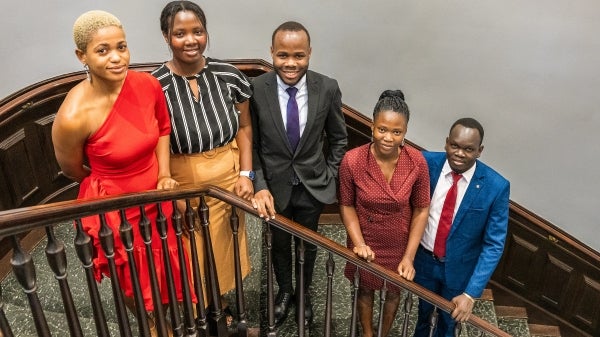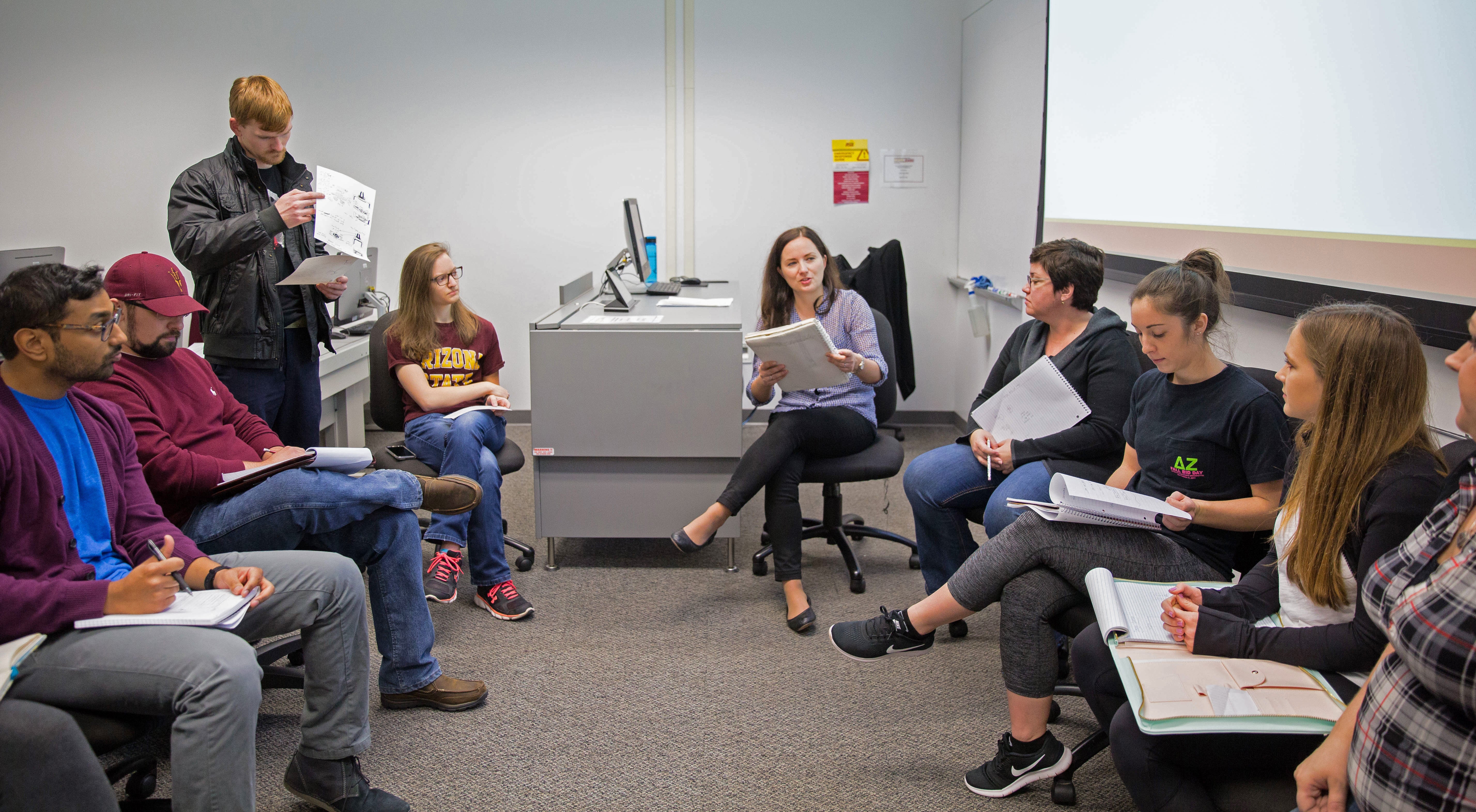ASU prof devising innovative tool for ‘unexpected’ writers

ASU assistant professor of technical communication and user experience Tatiana Batova is part of a team about to launch Responsive Writing Solutions, an innovative workgroup tool to help professionals in technical fields who have had little training in writing produce good-quality written communication. Above, Batova stands, appropriately, at the intersection of Innovation Way and Williams Field Road, on ASU’s Polytechnic campus. Photo by Deanna Dent/ASU Now
“As soon as you take one step up the career ladder,” the late management guru Peter Drucker aptly observed, “your effectiveness depends on your ability to communicate your thoughts in writing and in speaking.”
What does that mean for the millions of professionals in technical fields who are under-prepared for that reality?
“Lots of pain points,” according to Arizona State University professor Tatiana Batova, “and lost time and money for organizations they work in.”
Batova, who is an expert in professional and technical communication and user experience, is part of a team on the verge of launching a commercial software product to help these “unexpected writers”— professionals in technical fields who are increasingly required to do lots of kinds of writing in their jobs.
“The project started back when I was still a graduate student at the University of Wisconsin-Milwaukee, when I had the idea of developing software that could help ESL (English as a Second Language) engineers and scientists with their professional writing.
“As researchers and communication experts, we were always being hired by companies to do workshops with engineers and other technical specialists to help them become better writers,” she noted.
It got her to wondering: “Could a customizable writing software be created to guide engineers and scientists with the everyday writing they do at work?
“Interestingly, while we had placed our initial research focus on ESL writers,” continued Batova, who is fluent in English, German and Russian, “we soon found out that the fear of losing face due to poor writing was also a major concern for those for whom English was their first language. So with time, we broadened the focus."
Now, four years into her career as an assistant professor in the College of Integrative Sciences and Arts at ASU’s Polytechnic campus, Batova and the team, including her doctoral advisor and co-principal investigator, Dave Clark, are about to launch a patentable commercial product that shows high promise.
Their work received seed funding from UW-Milwaukee and has been supported this last year by a prestigious National Science Foundation (NSF) Innovation Corps (I-Corps) award.
“I-Corps is a program to boost the commercialization of select technology developed through NSF-funded research,” explained Batova. “In addition to monetary support, there’s a solid entrepreneurship curriculum that takes us through the paces of getting a viable product to market.”
"Our solution not only promises to help writers and companies save money and avoid embarrassing errors and lost business due to poor-quality texts, but also to dramatically increase the job satisfaction of the ‘unexpected writers.'"
— Tatiana Batova, assistant professor of technical communication and user experience
Extensive market research is required of grantees, and Batova and her collaborators thoroughly researched the software that’s currently available, to see where there were opportunities for differentiating their product.
Over the course of a year they also interviewed more than 200 "unexpected writers" in eight U.S. states, about the writing challenges they experience on the job. They also asked them to contribute design ideas for the robust intelligent writing system they were building.
“They were engineers, IT developers, graphic designers, and managers of engineering work groups who have had little training in writing but whose jobs increasingly depend on good-quality written communication,” she reported. “They showed overwhelming interest in our product.
“The data from the interviews indicate that our solution not only promises to help writers and companies save money and avoid embarrassing errors and lost business due to poor-quality texts, but also to dramatically increase the job satisfaction of the ‘unexpected writers.’”
The tool they’ve developed, Batova said, emphasizes clarity, conciseness, and global English: “The goal is to make the language simple enough for any reader to understand it.”
The system is very robust in its ability to learn.
“As workgroups start using it, the company can identify the documents they think are well done and relevant. The software picks up on rules and can make recommendations on usage and word choice based on analysis of previous documents,” she said. “It essentially can build an organizational style guide and an arsenal of examples of best-practices as well as text that can be re-used in relevant situations in the future.”
Testing the UX
Now that a prototype of the software is ready, Batova and her team will soon begin testing users’ experience with it.
Batova hopes to draw ASU students into this phase.
Professor Tatiana Batova and students in her User Experience course brainstorm product and service design improvements. The course, TWC 444/544, is popular with undergraduate and master’s students from a range of majors and colleges. In her courses, Batova works to engage students in a process similar to what she uses in her own research and development: using design thinking and participatory design practices to create and test prototypes with real people. Photo by Deanna Dent/ASU Now
“It would be a great opportunity for our bachelor’s and master’s students in technical communication to participate in a UX (user experience) project of this scale,” she added. “UX is a booming field, and this type of experience can help students secure internships and jobs.”
What will usability testing look like for this product?
“We’ll give the person a scenario and a task, like perhaps asking them to write an abstract for a proposal or a work email,” she said, “and then sit next to them and say, okay, show us how you would do that. We’ll be watching them, recording where they click, but also encouraging them to think aloud as they approach the task.
“We may make gentle inquiries like, ‘I see you’ve stopped; why? What are you thinking?’ We try to not to give them reactions that have positive or negative valence.”
The team has been building a website to promote the product, which they’ve named Responsive Writing Solutions, and some companies they have consulted with in the past have already expressed interest in being early-adopters.
“Our end goal is to be sure that working within the product is easy and intuitive. These people are very busy. For most of them, time spent learning new software — like time spent writing reports and proposals — is time away from what they’re best at: being scientists, developers, and engineers.”
More Business and entrepreneurship

Cohort of Mastercard Foundation Scholars poised to become AI leaders in Africa
Arizona State University is celebrating a significant milestone in expanding the university’s global access mission by welcoming…

Networking event turns pitches into partnerships
Perfect timing, quick decisions and electrifying energy are vital aspects of both startup ventures and auctions. In an…

Thunderbird at ASU, W. P. Carey School team up on concurrent master's degrees
Students are now able to take advantage of two world-class schools at Arizona State University, at the same time. The…
